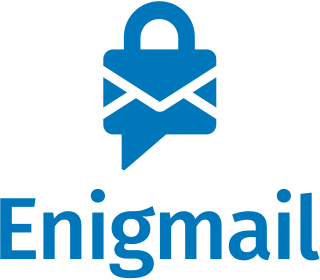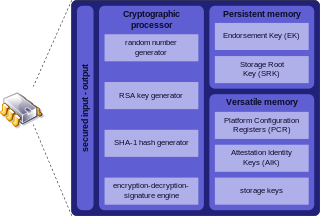Related Research Articles
Pretty Good Privacy (PGP) is an encryption program that provides cryptographic privacy and authentication for data communication. PGP is used for signing, encrypting, and decrypting texts, e-mails, files, directories, and whole disk partitions and to increase the security of e-mail communications. Phil Zimmermann developed PGP in 1991.
A cryptographically secure pseudorandom number generator (CSPRNG) or cryptographic pseudorandom number generator (CPRNG) is a pseudorandom number generator (PRNG) with properties that make it suitable for use in cryptography. It is also loosely known as a cryptographic random number generator (CRNG).

The Clipper chip was a chipset that was developed and promoted by the United States National Security Agency (NSA) as an encryption device that secured "voice and data messages" with a built-in backdoor that was intended to "allow Federal, State, and local law enforcement officials the ability to decode intercepted voice and data transmissions." It was intended to be adopted by telecommunications companies for voice transmission. Introduced in 1993, it was entirely defunct by 1996.

Enigmail is a data encryption and decryption extension for Mozilla Thunderbird and the Postbox that provides OpenPGP public key e-mail encryption and signing. Enigmail works under Microsoft Windows, Unix-like, and Mac OS X operating systems. Enigmail can operate with other mail clients compatible with PGP/MIME and inline PGP such as: Microsoft Outlook with Gpg4win package installed, Gnome Evolution, KMail, Claws Mail, Gnus, Mutt. Its cryptographic functionality is handled by GNU Privacy Guard.

The export of cryptography from the United States to other countries has experienced various levels of restrictions over time. World War II illustrated that code-breaking and cryptography can play an integral part in national security and the ability to prosecute war. Changes in technology and the preservation of free speech have been competing factors in the regulation and constraint of cryptographic technologies for export.

Trusted Platform Module (TPM) is an international standard for a secure cryptoprocessor, a dedicated microcontroller designed to secure hardware through integrated cryptographic keys. The term can also refer to a chip conforming to the standard ISO/IEC 11889.
In Microsoft Windows, a Cryptographic Service Provider (CSP) is a software library that implements the Microsoft CryptoAPI (CAPI). CSPs implement encoding and decoding functions, which computer application programs may use, for example, to implement strong user authentication or for secure email.
The Microsoft Windows platform specific Cryptographic Application Programming Interface is an application programming interface included with Microsoft Windows operating systems that provides services to enable developers to secure Windows-based applications using cryptography. It is a set of dynamically linked libraries that provides an abstraction layer which isolates programmers from the code used to encrypt the data. The Crypto API was first introduced in Windows NT 4.0 and enhanced in subsequent versions.

A hardware security module (HSM) is a physical computing device that safeguards and manages secrets, performs encryption and decryption functions for digital signatures, strong authentication and other cryptographic functions. These modules traditionally come in the form of a plug-in card or an external device that attaches directly to a computer or network server. A hardware security module contains one or more secure cryptoprocessor chips.
CryptGenRandom is a deprecated cryptographically secure pseudorandom number generator function that is included in Microsoft CryptoAPI. In Win32 programs, Microsoft recommends its use anywhere random number generation is needed. A 2007 paper from Hebrew University suggested security problems in the Windows 2000 implementation of CryptGenRandom. Microsoft later acknowledged that the same problems exist in Windows XP, but not in Vista. Microsoft released a fix for the bug with Windows XP Service Pack 3 in mid-2008.
Cryptography is the practice and study of encrypting information, or in other words, securing information from unauthorized access. There are many different cryptography laws in different nations. Some countries prohibit the export of cryptography software and/or encryption algorithms or cryptoanalysis methods. Some countries require decryption keys to be recoverable in case of a police investigation.
There are a number of security and safety features new to Windows Vista, most of which are not available in any prior Microsoft Windows operating system release.
In cryptography, PKCS #11 is one of the Public-Key Cryptography Standards, and also refers to the programming interface to create and manipulate cryptographic tokens.
The various versions of Microsoft's desktop operating system, Windows, have received various criticisms since Microsoft's inception.
Dual_EC_DRBG is an algorithm that was presented as a cryptographically secure pseudorandom number generator (CSPRNG) using methods in elliptic curve cryptography. Despite wide public criticism, including the public identification of the possibility that the National Security Agency put a backdoor into a recommended implementation, it was for seven years one of four CSPRNGs standardized in NIST SP 800-90A as originally published circa June 2006, until it was withdrawn in 2014.
There are various implementations of the Advanced Encryption Standard, also known as Rijndael.

Bullrun is a clandestine, highly classified program to crack encryption of online communications and data, which is run by the United States National Security Agency (NSA). The British Government Communications Headquarters (GCHQ) has a similar program codenamed Edgehill. According to the Bullrun classification guide published by The Guardian, the program uses multiple methods including computer network exploitation, interdiction, industry relationships, collaboration with other intelligence community entities, and advanced mathematical techniques.
Dell BSAFE, formerly known as RSA BSAFE, is a FIPS 140-2 validated cryptography library, available in both C and Java. BSAFE was initially created by RSA Security, which was purchased by EMC and then, in turn, by Dell. When Dell sold the RSA business to Symphony Technology Group in 2020, Dell elected to retain the BSAFE product line. BSAFE was one of the most common encryption toolkits before the RSA patent expired in September 2000. It also contained implementations of the RCx ciphers, with the most common one being RC4. From 2004 to 2013 the default random number generator in the library was a NIST-approved RNG standard, widely known to be insecure from at least 2006, containing a kleptographic backdoor from the American National Security Agency (NSA), as part of its secret Bullrun program. In 2013 Reuters revealed that RSA had received a payment of $10 million to set the compromised algorithm as the default option. The RNG standard was subsequently withdrawn in 2014, and the RNG removed from BSAFE beginning in 2015.

Attempts, unofficially dubbed the "Crypto Wars", have been made by the United States (US) and allied governments to limit the public's and foreign nations' access to cryptography strong enough to thwart decryption by national intelligence agencies, especially the National Security Agency (NSA).
FREAK is a security exploit of a cryptographic weakness in the SSL/TLS protocols introduced decades earlier for compliance with U.S. cryptography export regulations. These involved limiting exportable software to use only public key pairs with RSA moduli of 512 bits or fewer, with the intention of allowing them to be broken easily by the National Security Agency (NSA), but not by other organizations with lesser computing resources. However, by the early 2010s, increases in computing power meant that they could be broken by anyone with access to relatively modest computing resources using the well-known Number Field Sieve algorithm, using as little as $100 of cloud computing services. Combined with the ability of a man-in-the-middle attack to manipulate the initial cipher suite negotiation between the endpoints in the connection and the fact that the finished hash only depended on the master secret, this meant that a man-in-the-middle attack with only a modest amount of computation could break the security of any website that allowed the use of 512-bit export-grade keys. While the exploit was only discovered in 2015, its underlying vulnerabilities had been present for many years, dating back to the 1990s.
References
- ↑ Chappell, Geoff (12 September 1999). "CSP Signatures". Archived from the original on 4 May 2006.
- 1 2 Fernandes, Andrew (31 August 1999). "Microsoft, the NSA, and You". cryptonym.com. Cryptonym. Archived from the original on 17 June 2000. Retrieved 26 October 2005.
- ↑ "NSA key to Windows: an open question". CNN Online. Cable News Network. 5 September 1999. Archived from the original on 5 October 2015.
- ↑ Campbell, Duncan (4 January 1999). "How NSA access was built into Windows". Heise Online. Heise Medien.
- ↑ "Microsoft Says Speculation About Security and NSA Is "Inaccurate and Unfounded"". News Center. Redmond, WA: Microsoft. 3 September 1999. Archived from the original on 24 October 2012.
- 1 2 "There is no "Back Door" in Windows". Microsoft. 7 September 1999. Archived from the original on 20 May 2000. Retrieved 7 January 2007.
- ↑ "Windows NSAKEY Controversy". Rice University.
- ↑ "Mozilla Crypto FAQ". Archived from the original on 22 April 1999. Retrieved 12 April 2020.
- ↑ Schneier, Bruce (15 September 1999). "NSA Key in Microsoft Crypto API?". Counterpane. Retrieved 7 January 2007.
- ↑ "The reverse-engineered keys". Cypherspace. 6 September 1999. Retrieved 7 January 2007.